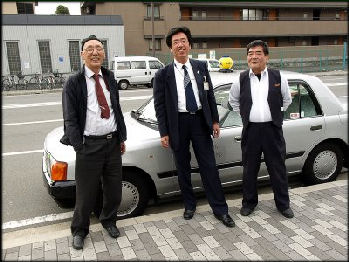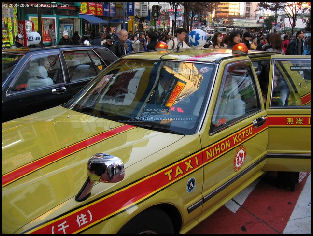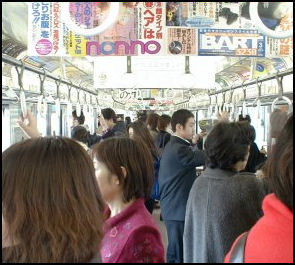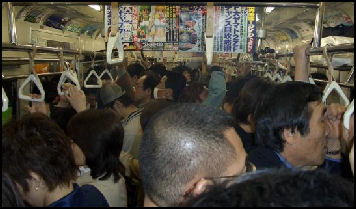URBAN TRANSPORTATION IN JAPAN

Kyoto taxi drivers Japan has one of the best urban mass transportation systems in the world. Nine cities in Japan currently operate subway systems. The first to be constructed, a section of Tokyo’s Ginza line, began operation in 1927. There are 13 subway lines in Tokyo, and they currently carry more than 7 million passengers per day. Many of the subway lines also link up with commuter lines and extend their service to the suburbs. In places without subways railways serve as mass transportation system. Everywhere there are good bus networks. Train stations are often close by. In many places it is possible to get by without a car. If all else fails it is easy to catch a taxi.
Japanese cities are very confusing. Most small streets have no name, addresses refer to a series of concentric areas, streets are sometimes numbered according to when they were built rather than their location, and taxi drivers respond to landmarks not street numbers. Commenting on how difficult it is to get around Tokyo, Sam Anderson wrote in the New York Times, “Japan — real, actual, visitable Japan — turned out to be intensely, inflexibly, unapologetically Japanese. This lesson hit me, appropriately, underground. On my first morning in Tokyo...I descended into the subway with total confidence, wearing a freshly ironed shirt — and then immediately became terribly lost and could find no English speakers to help me, and eventually (having missed trains and bought lavishly expensive wrong tickets and gestured furiously at terrified commuters) I ended up surfacing somewhere in the middle of the city, already extremely late for my interview, and then proceeded to wander aimlessly, desperately, in every wrong direction at once (there are few street signs, it turns out, in Tokyo) until finally Murakami’s assistant Yuki had to come and find me, sitting on a bench in front of a honeycombed-glass pyramid that looked, in my time of despair, like the sinister temple of some death-cult of total efficiency. [Source: Sam Anderson, New York Times, October 21, 2011]
Japanese spend significantly more time outside their homes and on public transport than Americans. Employers often pay commuting fees. City trains and subways in Japan are first-rate and service most destinations, even in small cities, but the routes can be very difficult to figure out for the first time user. Especially troublesome is the fact that there are often several different kinds of trains and subways available in Tokyo, Osaka and other cities. The map for the Tokyo subway looks like a wiring diagram for Cray super computer but with some patience you should be able to sort it out. Stations which hand several lines usually have color-coded circles and arrows that indicate the way.
Most taxis are spotlessly clean Toyota Crowns. They have passenger doors that are opened and closed by the driver using a remote control lever, so stand back. Some even have vibrating magic-fingers seats and VCRs which show old samurai movies. Taxi drivers and workers in other jobs wear white gloves. Taxi drivers wear white driving gloves for several reasons: 1) so their hands don't get sunburn; 2) to indicate the cleanliness of their vehicle; 3) to keep sweat off the steering wheel.
Public shared taxis are becoming increasingly popular in rural areas. They have appeared in areas where local bused have been taken off the road as cost-cutting ,measures. One town with 13,000 residents uses two station wagons and two minicars that run between the suburbs and the central part of town ever 30 minutes. Users call a reservation center run by a local chamber of commerce.
Websites and Resources
Transportation in Tokyo Good Photos at Japan-Photo Archive japan-photo.de ; Tokyo Subway Museum japaneserailwaysociety.com ; Tokyo City Government official site tourism.metro.tokyo.jp Tokyo Metro tokyometro.jp ; Japan Guide japan-guide.com ; Wikipedia Wikipedia Subway and Train Maps: Urban Rail Urbanrail.net Greater Tokyo Trains and Subways Tokyo Trains ; Tokyotopia PDF maps tokyotopia ;Tokyo Metro tokyometro.jp ; Joho Maps johomaps.com Tokyo Station JR East Tokyo Station Map jreast.co.jp ; Wikipedia Wikipedia ; Tokyo Station Map: Japan National Tourism Organization JNTO ; Shinjuku Station is Japan's largest train station. Wikipedia Article Wikipedia ; JR Map of Shinjuku Station jreast.co.jp
Transportation in Osaka Japan Guide japan-guide.com ; Osaka Convention and Tourism Bureau Osaka Info ; Subway and Train Maps: Urban Rail Urbanrail.net ; Joho Maps Joho Maps ; Osaka Japan.com osaka-japan.com; Osaka Station Map: Japan National Tourism Organization JNTO Transportation in Kyoto Kyoto City Web city.kyoto.jp ; Japan Guide japan-guide.com ; Kyoto University Kyoto University ; Kyoto Official Travel Guide by Kyoto Tourism Council Kyoto Travel ; Kyoto Prefecture Site Welcome to Kyoto ; Subway Map: Urban Rail Urbanrail.net ; Street and subway map kpic.or.jp ; Japanize Kansai railway map japanize.jp ; Kyoto Train Station: Welcome to Kyoto Kyoto Prefecture Site ; Wikipedia Wikipedia ; Kyoto Station Map: Japan National Tourism Organization JNTO
Links in this Website: BICYCLES AND MOTORCYCLES IN JAPAN Factsanddetails.com/Japan ; URBAN TRANSPORTATION IN JAPAN Factsanddetails.com/Japan ; TRAINS IN JAPAN Factsanddetails.com/Japan ; SHINKANSEN (JAPANESE BULLET TRAINS) Factsanddetails.com/Japan ; AUTOMOBILES AND DRIVING IN JAPAN Factsanddetails.com/Japan ; AUTOMOBILES ACCIDENTS IN JAPAN Factsanddetails.com/Japan ; HYBRIDS, FUEL CELLS AND ELECTRIC CARS IN JAPAN Factsanddetails.com/Japan ; AIR TRAVEL AND AIRLINES IN JAPAN Factsanddetails.com/Japan ; SHIPPING AND BOAT TRAVEL IN JAPAN Factsanddetails.com/Japan ; INFRASTRUCTURE AND PUBLIC WORKS IN JAPAN Factsanddetails.com/Japan
Good Websites and Sources on Transportation: Good Photos at Japan-Photo Archive japan-photo.de and japan-photo.de ; Ministry of Land, Infrastructure, Transport and Tourism mlit.go.jp ; Statistical Handbook of Japan Transport Chapter stat.go.jp/english/data/handbook ; 2010 Edition stat.go.jp/english/data/nenkan ; News stat.go.jp
History of Urban Transportation in Japan

busy taxi stand In the old days many people walked when covering long distances. Horses were not widely used. Packhorses were sometimes employed to carry belongings.
Initially waterways and canals were the main ways to get around Tokyo. Historian Masao Suzuk told the Yomiuri Shimbun canals and other waterways in Edo [Tokyo] were completed around 1690. Canals spread like a web connecting the two moats encircling Edo Castle, the Arakawa, Sumidagawa and other rivers. Using the water transportation networks, rice, wood, charcoal and other goods were carried throughout the city. Waterborne transportation waned with the development of rail and road networks. After World War II, more than half of the rivers and canals were reclaimed in Tokyo's 23 wards. [Source: Yohei Takei, Yomiuri Shimbun, October 24, 2011]
The first tramways in Japan began operating in 1882. They were pulled by horses. Around the turn of the century they were replaced by electric trains. Tokyo Station opened in 1914. The first above-ground tram line, the Yamanote Line in Tokyo, opened in 1925, two years after the Great Tokyo Earthquake. By the 1970s all the tram companies in Tokyo had folded. The only remaining trams in Japan are found in Hiroshima, Sapporo and Kumamoto.
In the early 1950s there was only 25 kilometers of subway lines in Japan. During the 1950s, 60s and 70s there was a great deal of subway construction. By the late 1960s, Tokyo had 110 kilometers of track. There are subways in eight Japanese cities with nearly 700 kilometers of track.
Today the eight Japanese cities with subays have nearly 700 kilometers of track. The subway system operates between 5:00am and 12:00 midnight. New automated trains used in the Odaiba and Arakawa areas of Tokyo run on elevated tracks, offering stunning views, and don’t have drivers.
In April 2008, a fire at a substation on the JR Chuo line in Tokyo brought train on the line a halt forcing 20,000 people to get off their trains and walk along the tracks in the rain. People at stations got stuck there for hours. All hell broke loose when a typhoon struck Tokyo in the summer of 2009 during the morning rush hour. Most train and subway lines closed. Some of the stations along the lines that stayed open closed because so many people crowded into them there was a danger of the platforms collpasing from the weight of all the people waiting for trains.
Crowded Subways in Japan

Rush-hour trains and subways in Japan can be quite crowded. One commuter told the Daily Yomiuri, "Every morning, I pack myself into an overcrowded train, so by the time I arrive at work, I'm already exhausted.
Annual subway passenger trips (2006): 1) Tokyo (2.9 billion); 2) Moscow (2.6 billion); 3) Seoul (2.4 billion); 4) New York City (1.5 billion); 5) Mexico City (1.4 billion); 6) Paris (1.4 billion); 7) London (971 million); 8) Osaka (880 million); 9) Hong Kong (867 million); 10) St. Petersburg (810 million).
The Yamanote line in Tokyo is one of the world’s busiest subway lines. Completed in 1925 and running a 35 kilometers loop through the heart of the city, it carried between 3 million and 4 million passengers every day.
The JR Saikyo Line is known as one of the most crowed rush hour trains in Tokyo. Describing a ride Chie Matsumoto wrote in the Asahi Shimbun: “Hell is probably not as crowded as a commuter train in Tokyo...I was shoved through...the carriage. I was smashed. I was stepped on and squeezed. At last I was devoured....If someone stepped on my foot that meant I had my feet on the floor; I was smacked about I had some room to breathe....I tried not to think about the person breathing hotly — in and out, in and out — on the back of my head.”
Describing the scene at busy Kawasaski station in Tokyo, Sheryl WuDunn wrote in the New York Times, "As the doors were about to close...a young Japanese woman rushed to the platform, bowed deeply in courtesy to the crowded tangle and then charged into the human mesh...Some just thrust themselves in. Some slip in on the side. Japanese trains are usually on schedule and so those who time their commutes down to the minute often prefer the last-in, first-out method, which they must maneuver in just as the doors are closing."
The trains are so packed that people routinely faint. "On a bad day, we could have three o four people falling sick," a train employee told the New York Times. "Many of them are women who are skinny, who skip their breakfast or are on a diet, and they're not able to cope with rough crowds in the train."
Tushy Pushers and Japanese Subways

During rush hour hired "tushy pushers" shove people into the trains. One female tushy pusher told the New York Times, "it's not a very good feeling to be pushing passengers, for its kind of troubling them." Pushing both men and women is awkward she said, "if their back is toward us, it's easier, but if they're facing us, its harder because there's no proper spot to push them, though we try to push their bags or something else they are holding. In any case, we always say first. We will push you."
Station attendants with white gloves still shove passengers into subways cars on crowded subway lines — as Life magazine showed them doing in the 1960s. The cars often hold more than twice the capacity they have been built for. The most crowded train in Japan is the stretch between Ueno and Okackimachi stations on the JR Keohin Tohuku Line.
In recent years Tokyo's trains and subways have less slightly less crowded. They are still crowded. Cars at rush hour are packed to a 183 percent of capacity but this is better than 221 percent of capacity, which was the case in 1975. One pusher told AP, "We used to have to pull back the passengers who couldn't squeeze their way in. Now we can push them all in."
Reasons why the trains are less crowded include new lines, more trains on existing lines, falling birthrate, the increase in part time workers who work flexible hours. Plans to build more lines to reduce capacity to 151 percent will cost about $40 billion.
Subway and Train Etiquette in Japan

Lady's seat Passengers line up at special marks o the platform to reduce the time that a train spends at each station to as little as 30 seconds. Those waiting to get on patiently wait for those get off before boarding.
Once on the subways, Japanese subway riders are pretty quiet. Many Japanese commuters fall asleep almost instantly after getting on the subway. Many of those who are awake play games or send messages with their cell phones. Talking on cell phones is discouraged. Some commuters favor positions which allows them to read or sleep. During the winter when people are bundled up in winter coats, they have more padding to absorb the pushing and shoving but less people can be squeezed into a train car.
Passengers on subways are expected not to sprawl across their seats, put their feet on the seats, eat or drink on the train (although a lot of people do this), put on their make up, talk on their cell phones or even listen to music on their I-pods. There are even posters that make the point.
There are special seats reserved for elderly people, pregnant women, injured people and women with young children. It is okay for other people to sit on these sas but if someone form he aforementioned groups shows they are expected to give up their sets t them.
In Yokohama teams of “courtesy staff” are employed on trains to encourage passengers to give up their seats for elderly or disabled passengers. Each team is accompanied by a security guard to ensure there is no trouble.
Japanese Subway Molesters

One of most notorious and embarrassing fixtures of the Japanese commuter life is the subway molester, a male who enjoys the opportunities presented by a crowded to subway to touch and fondle women's breasts, buttocks and legs. Men have also been caught with cameras in their shoes that allow them to take photographs up a woman’s skirt. [Source: Sherly Wu Dunn, New York Times, December 17, 1995]
Molesters are known as “chikan”. Most are salarymen in their 30s and 40s. Some have confessed that they have molested women in subways everyday for more than 25 years. The number of report chikan cases on trains in the Tokyo metro area rose from 778 in 1996 to 1,338 in 1997 to 2,101 in 2000 to 2,201 in 2004. The cases involve unwanted grabbing f the buttocks, breasts or between the lags and may even involve ejaculation. Obviously there are many more cases that are not reported.
"When men and women are packed together, squeezed onto a train, I think everybody has some of desire to touch someone else," Samu Yamamoto, a member of molesters club, told the New York Times. "If someone were molesting on a train somewhere else in the world, they'd be accused of sexual harassment. It's unique to Japan that people put up with this."
Yamamoto has written about his experiences and said he met his wife after grabbing her on a subway. He says that his club meets occasionally to share tips and says the Christmas-New Year's holiday season is one of the best times for groping. "There lots of year-end parties and many women get drunk," he said, "so there will be plenty of good opportunities." For a while Yamamoto hosted a late-night television show called “Chikan Hyakka” (Encyclopedia of Groping) un which eh gave advise to prospective chikkab who wore ski masks to hide their identity,
Tokyo’s Saikyo Line Popular with Gropers
The JR Saikyo Line, which links Tokyo and Saitama Prefecture, has a reputation among gropers as being an "easy" place to molest passengers. In June 2012, the Yomiuri Shimbun reported: “Reported groping cases on the JR Saikyo Line have increased despite the installation of security cameras in some cars, apparently because gropers are targeting passengers in areas that are not under surveillance, according to the police. According to the Metropolitan Police Department, 1,244 cases of groping on trains were investigated last year in Tokyo, down 45 from 2010. However, cases on the Saikyo Line increased by 36 to 136. [Source: Yomiuri Shimbun, June 15, 2012]
“The number of reported cases of groping on the Saikyo Line fell after East Japan Railway Co. installed security cameras in some cars in December 2009. Station staff are conducting patrols and in-train announcements to alert passengers are being made more frequently as part of move by JR East to snuff out the groping problem. "It seems the deterrent of the cameras has worn off," a JR East official said.
“When Saikyo Line trains stop near the busy Shinjuku and Shibuya stations, the cars at the northern end of the train stop near ticket gates and become especially crowded. Passengers on commuter express trains are cooped up for relatively long periods because the trains make few stops, and doors on one side stay shut for quite a long time--conditions that apparently were behind messages posted on the Internet that claimed molesting passengers on the Saikyo Line is simple.
“In a national first, JR East experimentally installed a total of six security cameras on two Saikyo Line trains to deter gropers. The first two cameras began filming inside the last car of a Tokyo-bound train during the rush hour in December 2009. The project initially had some success, with 136 groping cases reported to police in 2009, down 28 from the previous year. When security cameras were installed on all Saikyo Line trains in 2010, the number of cases fell to 100--the fewest in the past decade. JR East and the MPD suspect the rebound in molestation cases is possibly the result of gropers avoiding cars with security cameras. The train operator does not plan to install more cameras. Instead, JR East will take steps such as deploying more station staff on platforms to make it easier for passengers to report crimes.
Victims of Subway Molesters
A typical victims is on crowded train in which the passengers are squeezed against one another and there is so little space one can not even turn around. She is groped from behind and is unsure what to do and remains quiet. When she finally get a chance to turn around she faces three middle-aged salarymen and is unsure which one is the groper.
Many regular female subway riders say they have been grabbed at least once. One survey of high school girls found that 72 percent had been molested on a trains — most more than once. When police questioned victims of the Kobe earthquake in 1995, more women complained about subway molesters than the earthquake.
A survey by the Tokyo metropolitan government found that two of three women in their 20s and 30s have been groped on a train. Of these who had been griped about half said they endured it they could flee, a third said they tried to stop the molester. A third said they gave been molested in the past years, 40 percent said they had been molested three to five times. About 12 percent cent said they had been groped 11 times or more
Some victims complain that molesters have slipped a hand under their dresses and into their panties and slid a hand into their blouses to unhook their bras. One victim told the New York Times that she was so horrified when a molester slipped his hand under her bra she went out immediately and bought new clothes. Another said she saw a man fingering the undergarments of woman. "The train was so crowded she couldn't get away from him. At the next station she stepped out to change cars, but he followed her," she said.
Fighting Back Against Subway Molesters
Some women grab the molesters by their testicles and give them powerful squeeze, but the problem is that the subways are often so crowded they often don't know who is molesting them. Other women carry large hat pins, which serves two purposes: it allows women to give a groping hand a painful stab and when the owner of hand yells out, the women can find out who their attacker is.
One woman who said she was grabbed by the same man day after day when she took subway home from school told U.S. News and World Report, "One day I got so fed up I grabbed [his] hand and held it up for everyone to see. He never did it again,"
New women-only subway cars were introduced in February 2001 partly to help women escape groping. Many women like the segregated subway system. The number of chiackan assaults has not decreased though .
The government has organized a nationwide campaign: “Chikan-wa Hanzai-da” ("Groping Is a Criminal Offense"). Anti-groping posters are hung in subway stations. Some of them featured pretty teenage girls in school uniforms that probably did more to excite than discourage potential gropers,
In December 2005, a 40-year-old businessman died after being caught molesting a young woman on a packed train in Osaka. The man groped a 20-year-old student in the morning rush hour and then tried to escape by running into busy Tennoji station, where he was tackled by a 32-year-old off-duty police officer and passengers on the train. The man lost consciousness and later died.
Police and Subway Molesters
The maximum sentence for groping is a ¥1 million fine and a prison sentence of 10 years for repeat offenders. Sometimes forensic specialist are called in to prove groping has taken place by matching fibers found on the suspects hands — extracted using a special sticky film applied to the hands — with those released by the victims clothing using a micro spectrophotometer. A hand that accidently brushes against the clothing does not pick up fibers like groping does. .
Most of the women claim that police and subway train masters are uncooperative and ignore their problem. One train master disagreed. He told the New York Times he tries to help but the vast majority of incidents are unreported. Recalling one incident, he said, "The woman didn't insist on calling the police and the guy admitted he did it but said he was repentant. We generally bring the woman to our office to sooth her and we reprimand the people who commit the crimes."
Some men have been falsely accused of molesting. One man in Nagasaki was arrested for groping and spent 21 days in prison but insisted that all he did was bump into the woman who accused him. Another man, in Tokyo, was accused by a woman of undoing his zipper and forcing a girl on a subway to fondle him even though he was wearing button-fly pants and had an overcoat on over that. He was arrested and jailed but was ultimately had the charges against him dropped but not before he spent $50,000 in legal fees and lost his job.
Men have killed themselves after being accused of groping. In August 2008, a 25-year-old man leapt to his death from a second floor while being questioned by police for allegedly touching a woman while she was swimming at Utsumi Beach in Aichi Prefecture. The man was impaled on iron railing below the veranda he leapt off of.
Image Sources: 1) 5) Ray Kinnane 2) 4) Andrew Gray Photosensibility 3) Jun of Goods from Japan 6) Pictures Tokyo
Text Sources: New York Times, Washington Post, Los Angeles Times, Daily Yomiuri, Times of London, Japan National Tourist Organization (JNTO), National Geographic, The New Yorker, Time, Newsweek, Reuters, AP, Lonely Planet Guides, Compton’s Encyclopedia and various books and other publications.
Last updated July 2012
